#Algorithm Development
Explore tagged Tumblr posts
Text
From Science Fiction to Daily Reality: Unveiling the Wonders of AI and Deep Learning
Deep learning is like teaching a child to understand the world. Just as a child learns to identify objects by observing them repeatedly, deep learning algorithms learn by analyzing vast amounts of data. At the heart of deep learning is a neural network—layers upon layers of algorithms that mimic the human brain’s neurons and synapses. Imagine you’re teaching a computer to recognize cats. You’d…

View On WordPress
#AI Ethics#AI in Healthcare#AI Research#Algorithm Development#Artificial Intelligence#Autonomous Vehicles#Computer Vision#Data Science#Deep Learning#Machine Learning#Natural Language Processing (NLP)#Neural Networks#PyTorch#Robotics#TensorFlow
0 notes
Text
Algo trading, short for algorithmic trading, is a revolutionary approach to financial markets that leverages computer algorithms to execute trading strategies.
#Algo Trading#financial markets#Algorithm Development#Data Collection and Analysis#Automated Execution
0 notes
Text
Quantum Computing: Illuminating The Path To Tomorrow's Innovations

INTRODUCTION
In the ever-evolving landscape of technology, quantum computing emerges as a revolutionary paradigm, promising to reshape industries, solve complex problems, and accelerate scientific advancements. With the potential to process information in ways previously thought impossible, quantum computing stands at the precipice of a new era, offering unparalleled computational power and opening doors to previously unimaginable possibilities. This article delves into the fascinating world of quantum computing, exploring its principles, applications, and the transformative impact it’s likely to have on our future.
THE QUANTUM REVOLUTION UNVEILED
Traditional computers rely on bits, which can be either 0 or 1, to process information through binary code. Quantum computers, on the other hand, leverage the peculiar principles of quantum mechanics, utilizing quantum bits, or qubits, which can exist in a superposition of both 0 and 1 states simultaneously. This property allows quantum computers to perform multiple calculations at once, exponentially increasing their processing power compared to classical computers for certain types of problems.
HARNESSING QUANTUM PHENOMENA
Two key phenomena, superposition and entanglement, form the foundation of quantum computing’s power:
Superposition: Qubits can exist in multiple states at once, enabling quantum computers to process a vast amount of information in parallel. This inherent capability makes them exceptionally adept at solving complex optimization, cryptography, and simulation problems.
Entanglement: Qubits can become entangled, where the state of one qubit instantaneously affects the state of another, even if they are separated by vast distances. This phenomenon allows for enhanced communication and improved error correction in quantum systems.
APPLICATIONS AND POTENTIAL IMPACT
Quantum computing’s capabilities hold enormous potential across various domains:
Cryptography: Quantum computers could revolutionize encryption and decryption methods, rendering currently unbreakable codes vulnerable. This could lead to the development of quantum-resistant cryptography to safeguard sensitive data.
Optimization: Quantum computing can tackle complex optimization problems found in logistics, supply chain management, and financial modeling, significantly improving efficiency and decision-making processes.
Drug Discovery: Quantum simulations could accelerate drug discovery by modeling molecular interactions at an atomic level, potentially leading to faster identification of effective drugs and therapies.
Artificial Intelligence: Quantum computing can enhance machine learning algorithms, enabling more rapid training of AI models and the exploration of complex data sets.
Climate Modeling: Quantum simulations could contribute to more accurate climate models, helping scientists better understand and mitigate the effects of climate change.
CHALLENGES AND THE ROAD AHEAD
While the promises of quantum computing are exhilarating, several challenges must be addressed:
Qubit Stability: Qubits are sensitive to their environment and can be easily disrupted, leading to errors in calculations. Developing error-correction techniques and improving qubit stability are ongoing challenges.
Scalability: Building quantum computers with a sufficient number of qubits to solve complex problems remains a formidable task. As qubit count increases, maintaining coherence becomes increasingly difficult.
Cost and Accessibility: Quantum computers are currently expensive to build and operate, limiting accessibility. As the technology matures, efforts to democratize access will be crucial.
Algorithm Development: Traditional algorithms are inadequate for quantum computers. Developing quantum algorithms that harness the full power of quantum mechanics is an ongoing area of research.
CONCLUSION
Quantum computing represents a leap into the future of computation, offering transformative capabilities that can reshape industries, drive innovation, and tackle some of the world’s most pressing challenges. While we are still in the early stages of harnessing the full potential of quantum computing, the progress made so far underscores its promising trajectory. As researchers, engineers, and innovators continue to push the boundaries of this field, the day when quantum computers revolutionize industries and our understanding of the universe draws ever closer. The future is quantum, and it holds boundless possibilities for those who dare to explore its mysteries.
1 note
·
View note
Text
I don’t have a posted DNI for a few reasons but in this case I’ll be crystal clear:
I do not want people who use AI in their whump writing (generating scenarios, generating story text, etc.) to follow me or interact with my posts. I also do not consent to any of my writing, posts, or reblogs being used as inputs or data for AI.
#not whump#whump community#ai writing#beans speaks#blog stuff#:/ stop using generative text machines that scrape data from writers to ‘make your dream scenarios’#go download some LANDSAT data and develop an AI to determine land use. use LiDAR to determine tree crown health by near infrared values.#thats a good use of AI (algorithms) that I know and respect.#using plagiarized predictive text machines is in poor taste and also damaging to the environment. be better.
292 notes
·
View notes
Text
Sport!AU anyone?




#now don't ask me to develop this cause i suck at sports and hate sports#i just wanted to do silly little moodboards#probably ruined my pinterest algorithm but they look so cute it was worth it#peter parker#joaquin torres#bob reynolds#johnny storm#tom holland#danny ramirez#lewis pullman#joseph quinn#pbjj#pb&jj#pb+jj
92 notes
·
View notes
Text
Random Mouse Algorithm
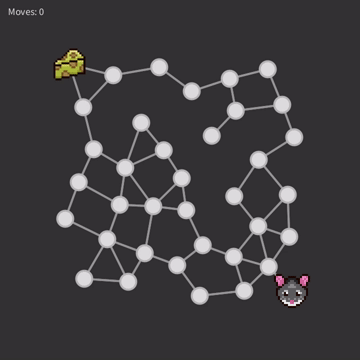
The 'Random Mouse Algorithm' is the best maze solving algorithm in the universe. It uses less memory than other wasteful pathfinding algorithms like 'Breadth First Search' and 'A-star'. Since it picks a random node at every junction.
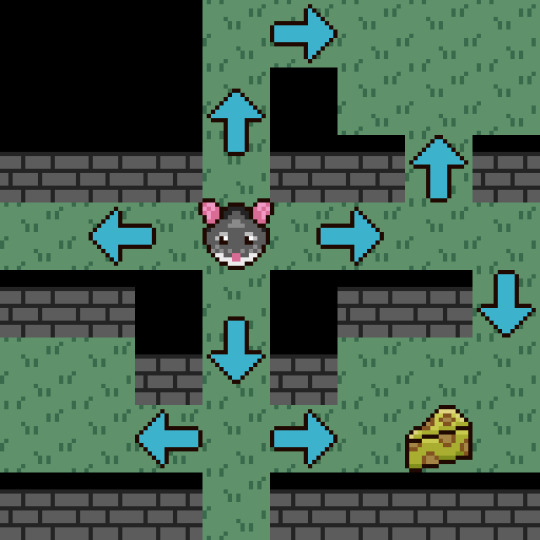
So there is no need for complicated containers like queues and stacks. The only downside, it's very slow… But it's guaranteed to find the goal (or cheese) eventually! It also won't find you the shortest path, but there is nothing wrong with taking the scenic route 🐭🧀
#pixel art#ドット絵#gamedev#indiedev#game development#maze#pathfinding#search algorithm#node graph#mouse#cheese
23 notes
·
View notes
Text
I spent five years coming up with unique ways to photograph the same group of plushies to help tell a story.
You don't need AI to help you be creative, you're just being lazy and want brain chemicals without doing any of the work or respecting the people who put time and effort into it.
#if i could develop a compelling narrative with a Pikachu plush and an Eevee i found at a Goodwill#you can do better than an algorithm#being creative is difficult but that's part of what makes it rewarding!#don't let the slop machine have your imagination algorithms have already taken so much from you#full disclosure i actually DO use Perplexity as an add on to Google and sometimes i have it help me with code#i do think having a computer assist you with creating automation can be good!#there ARE good AI tools - at least on paper#there's the whole power consumption thing which is...not great and i do admit i might not be blameless for that reason#but as an alternative for daydreaming?#GO MAKE YOUR OWN#it's okay if it's derivative sometimes!#you're not an impostor unless you're actively stealing from creatives#and you'll never guess what image generation does#it's not even generation actually it's just rehashing#anyways DeviantArt is essentially unusable now#i want real creativity please no more LLM trash thank you#artists deserve more respect#and i hope Microsoft is punted directly into the Sun
10 notes
·
View notes
Text
Does anyone else get frustrated by late stage capitalism's obsession with the monetization of free time?
#its starting to feel like anytime someone develops a skill or becomes really passionate about something#everyones first question is “are you going to do that for money?”#i get this about my writing all the time#ill tell someone writing is my main hobby and that ive written novel length fanfics#and the first thing i get asked the MAJORITY of the time is#“are you going to write a novel?”#no#no im not#i write fanfictions because i LIKE WRITING FANFIC#i dont want to publish a novel or persue a carrier as a writer#i see this all the time with online artists too#where there's this like.... PRESSURE to start taking commissions#but why?#why does the thing you do for fun HAVE TO become a source of income?#is it not enough to just enjoy a hobby?#why do all social media platforms push an algorithm so hard?#what if i dont care about my follower count or my engagement because im not here to be an influencer and celebrate follower milestones#i don't care how many people reposted my recent tiktok or shared my insta post to their story#what happened to just ENJOYING what you're passionate about#i hate it
7 notes
·
View notes
Text
Procedural Dungeon Generation
Alright~ After much work we have finally completed our dungeon generation algorithm. First, we generate the rooms, separate them using a separation steering algorithm.
Second, we generate a graph that represents connections between the various rooms

Third, we perform what is known as Delaunay Triangulation, in which we evaluate pairs of triangles and swap their shared edge if it fails a test boiled down to a simple matrix determinant evaluation Fourth, we construct a Graph of connectivity from the Delaunay triangulation

Fifth, we perform an A* pathfinding algorithm to connect points on the delauney triangulation through the neighborhood graph
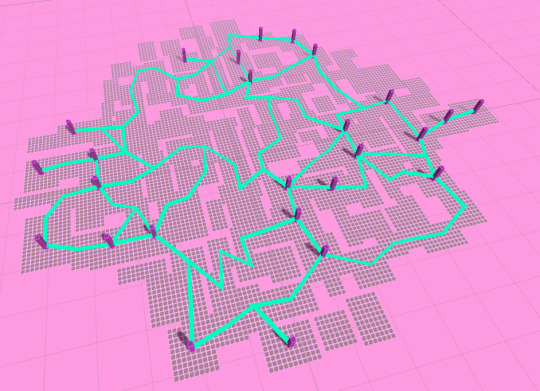
Finally, if we didn't traverse through a room, we can remove it to simplify the dungeon into something a little less dense
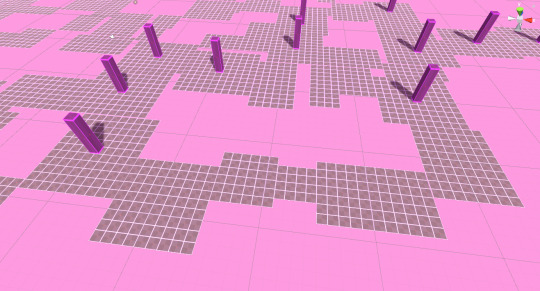
There are some extra things we can do here and there, and bugs and edge cases to iron out here and there, but for now, we have a pretty neat little dungeon generator. The next step is to actually procedurally generate the rooms and then use the connectivity graphs to implement game logic and whatnot, but that we will save for another time.
#procgen#procedural generation#gamedev#game dev#game development#unity3D#progblr#mathblr#graph theory#Delaunay triangulation#pathfinding#algorithms#mathematics#programming#math#Good fucking god that was way more difficult than I expected it to be
72 notes
·
View notes
Text
I forget to link this, but I do have a side-blog for primarily reblogs! If you like a lot of haha and screaming into the void stuff. Probably art too. @opinioncat
Also for the foreseeable future, I'll no longer be posting on Xitter (until it gets a new owner, or it burns to the ground).
Bluesky is now where most of my ramblings will be posted! It's been such a breath of fresh air in comparison to the hellhole that the ex-bird turned into. Tons of artists are there already. I'll still post stuff here, no worries.
#social media update#Blueskys block features are so nice too#and no algorithm!!#or ads#and they're still developing it
14 notes
·
View notes
Text
In the dynamic landscape of financial markets, algorithmic trading has emerged as a cornerstone of modern trading practices, revolutionising the way transactions are executed. This article delves into the basics of algorithmic trading, unravelling its meaning, core concepts, and practical applications through illustrative examples.
0 notes
Text

We haven’t started homeschooling yet because I wanted my big kid to have a substantial break. Often I feel crazy and like a bad parent because I have a school-aged child who is currently not in school. This feels like neglect.
But it also felt abusive to drop a child off at a place where he spent hours lowkey suffering every day. It was horrible watching him have multiple meltdowns a week. It was sad when he had no energy to do anything other than zone out on his electronics. There were no friend prospects in sight.
He’s still spending too much time on his electronics. But he also had another hangout with his new friend N yesterday. We met her and her mom at the local coffeehouse, and the kids played card and board games for two hours. Tomorrow I’m dropping him and Riv off at my parents’ where they’ll see a play, go to a Christmas tree farm, and go to church. I can reasonably expect him to be able to handle these activities instead of being worried that he’s too stressed out to deal with them. And today he joined Dominic and me for lunch at Mr. Chen’s, a delicious restaurant and Asian grocery store. He ate gyoza and tried crispy chicken. He bought these little bananas that he loves, which he used to get with his dad at the Asian market in Omaha.
We will figure out how to educate him. I’m sure it will be a bumpy ride at times. Most of the time I feel certain that he should be in school and not watching YouTube videos on his phone all day, but we’ll get there. And in the meantime I’m really grateful for the relative calm after weeks of high-strung dysfunction. He’s calmer, more loving and affectionate, and he’s more flexible too.
Anyway, I feel like an awful parent! I feel like a great parent!
#another positive development is that I require him to watch a science video on his phone every day#and it’s retrained his algorithm to show him more educational content#which i appreciate#homeschool chronicles
11 notes
·
View notes
Text
Sometimes I feel like the discourse about AI art misses the actual point of why it’s not a good tool to use.
“AI art isn’t ‘real’ art.” —> opinion-based, echoes the same false commentary about digital art in general, just ends up in a ‘if you can’t make your own store-bought is fine’ conversation, implies that if art isn’t done a certain way it lacks some moral/ethical value, relies on the emotional component of what art is considered “real” or not which is wildly subjective
“AI art steals from existing artists without credit.” —> fact-based, highlights the actual damage of the tool, isn’t relying on an emotional plea, can actually lead to legally stopping overuse of AI tools and/or the development of AI tools that don’t have this problem, doesn’t get bogged down in the ‘but what if they caaaaan’t make art some other way’ argument
Like I get that people who don’t give a shit about plagiarism aren’t going to be swayed, but they weren’t going to be swayed by the first argument either. And the argument of “oh well AI art can’t do hands/isn’t as good/can’t do this thing I have decided indicates True Human Creativity” will eventually erode since… the AI tools are getting better and will be able to emulate that in time. It just gets me annoyed when the argument is trying to base itself on “oh this isn’t GOOD art” when AI does produce interesting and appealing images and the argument worth having is much more about the intrinsic value of artists than the perceived value of the works that are produced.
#anyway ignore this bitching#me putting on my clown suit since I know tumblr doesn’t have reading comprehension#there is no intrinsic moral value to the use of AI because the AI is not a conscious thing#it is an algorithm and like all algorithms it can be applied and developed in harmful ways#for example my disabled ass loves having my Amazon echo so I can turn on the lights even when my pain is bad#but I hate being advertised and listened to#neither of these things are the outcome of the fact that there is hardware and software to translate and implement my voice commands#it’s about the users and developers of the tool and their intent
63 notes
·
View notes
Text
relax, if ivan2 scores one goal every 2.9 minutes in the third period, we can still win 7-6*
#avs lb#*I factored in the goals we’ll let them score using an advanced algorithm i developed specifically for this circumstance
5 notes
·
View notes
Text
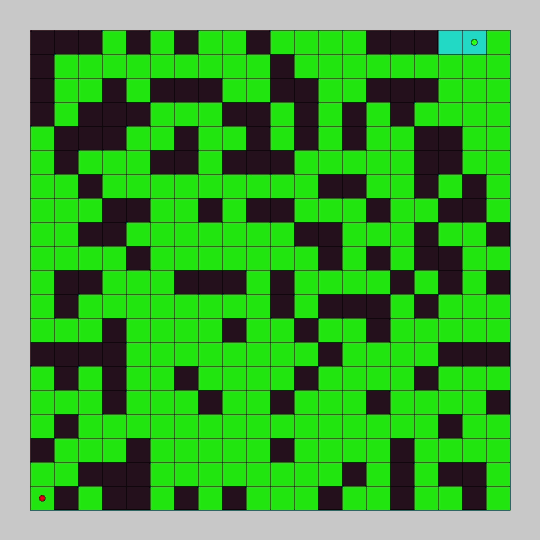
Learn how to explore a grid and find a goal point with breadth first search in this pathfinding tutorial. You will use Processing and Java to code the breadth first search pathfinding algorithm and create a graphical demo so you can see it in action.
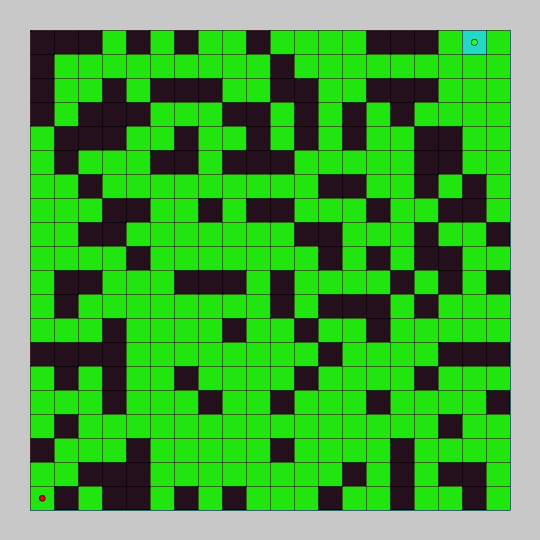
In the last tutorial, we programmed depth first search and watched it explore a node graph. In this tutorial we will program breadth first search and watch it explore a grid.
The breadth first search algorithm will add every unexplored adjacent node to a queue, and explore all of the added nodes in sequence. For each node explored, it will continue to add the adjacent unexplored nodes to the queue. It will continue to do this until the goal is found or all connected nodes have been explored.
#gamedev#indiedev#maze#pathfinding#game development#coding#creative coding#programming#Java#processing#search algorithm#tutorial#education#breadth first search#grid
18 notes
·
View notes
Text
Array Sorting in C++: A Quick Guide ✨
Hey coders! 👋 Let's talk about something super useful: Sorting Arrays in C++. Whether you are a newbie or brushing up your skills, this is essential knowledge.
What's the Deal with Sorting? 🤔 Sorting means putting your array elements in order (ascending or descending). It's crucial for making data easier to search, analyze, and work with.
Key Sorting Ideas 💡
Comparison & Swapping: Most sorting methods compare elements and swap them if they're in the wrong order. Think of it like rearranging books on a shelf!
Iteration: Sorting involves going through the array multiple times. It’s like checking every item to make sure it’s in the right spot.
Sorting Order: Usually, we sort from smallest to largest, but you can also sort from largest to smallest, or by any custom rule.
Choosing the Right Method: Different tasks require different methods.
Simple Methods (Bubble, Insertion): Easy to grasp but slow for big arrays. Great for learning the basics! Efficient Methods (Quick, Merge): Faster for large amounts of data but a bit more complex.
Sorting in Action 🚀
Manual Sorting: Write your own sorting code using loops and if statements. Good for understanding how it works under the hood.
Using std::sort(): C++'s built-in function that's super fast and easy to use.
#including<algorithm> int arr[] = {5, 3, 8, 6, 2}; int n = sizeof(arr)/sizeof(arr[0]); std::sort(arr, arr + n); // Sorts in ascending order
Custom Sorting: Sort your way by using a special function to define your own sorting logic.
Quick Guide Table 📚

Sorting is super important for any C++ project! 💻 Hope this gives you a clearer picture. 🎉
4 notes
·
View notes

